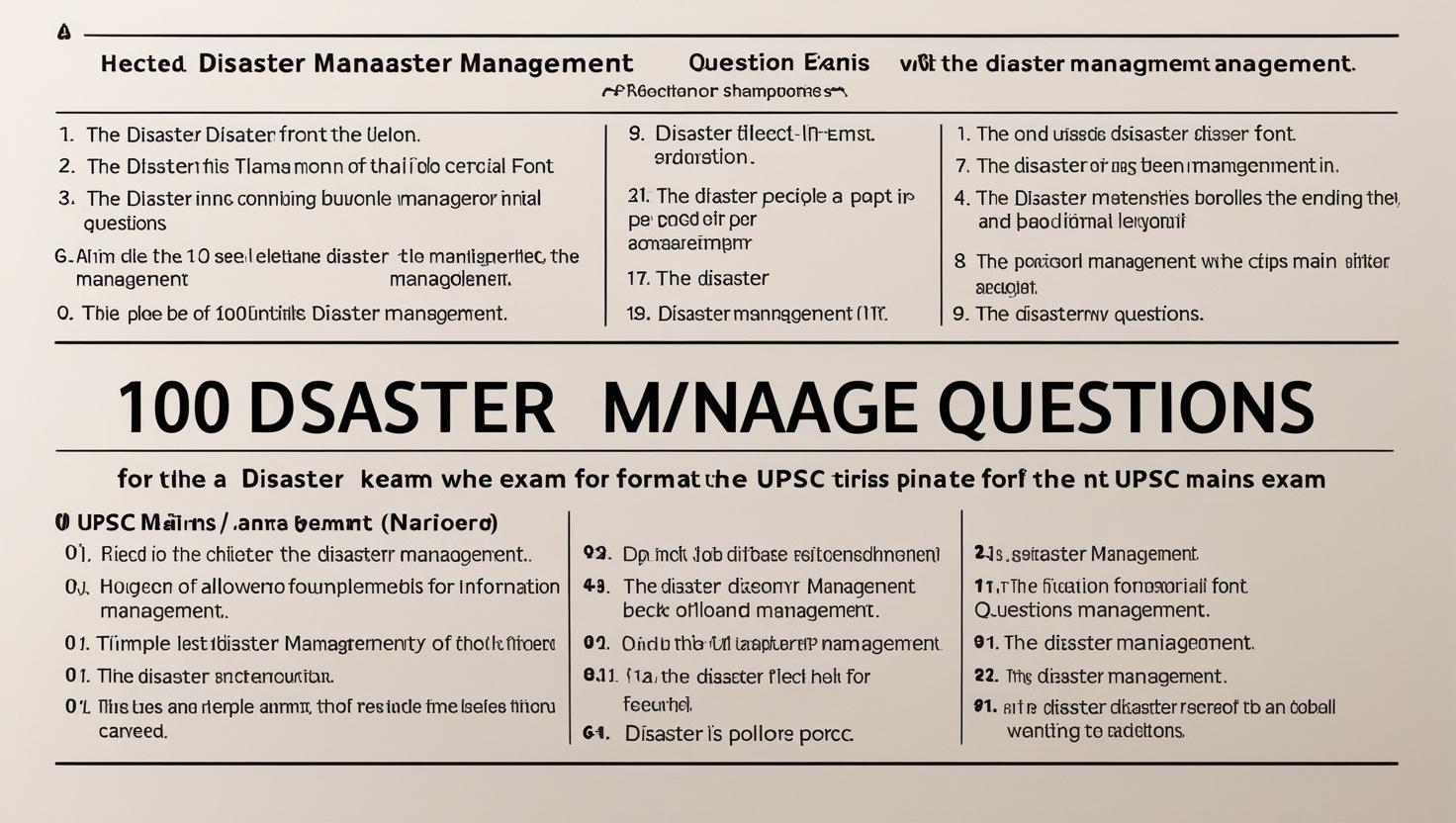Description
Disaster Management is an important segment of the UPSC General Studies Paper III, focusing on the mitigation, preparedness, response, and recovery strategies in dealing with disasters. This compilation of 100 questions is divided into chapters in line with the UPSC syllabus, ensuring comprehensive coverage for effective preparation.
For UPSC Coaching , Join FIRST IAS INSTITUTE (India’s Top IAS Coaching)
Chapter 1: Basics of Disaster Management
- Define disaster and explain its classification.
- Differentiate between natural and man-made disasters with examples.
- Explain the disaster management cycle and its components.
- Discuss the importance of preparedness in disaster management.
- Explain the concept of hazard, vulnerability, and risk.
- Discuss the role of early warning systems in disaster prevention.
- Explain the difference between hazard mitigation and disaster response.
- Discuss the role of capacity building in disaster management.
- Explain the importance of community-based disaster management.
- Discuss the concept of resilience in disaster management.
- Explain the role of scientific research in disaster prediction.
- How does climate change affect disaster frequency and intensity
- Discuss the relationship between urbanization and disaster risk.
- Explain the impact of population density on disaster management.
- Discuss the importance of risk mapping in disaster planning.
Chapter 2: Institutional Framework for Disaster Management
- Discuss the role of the National Disaster Management Authority in India.
- Explain the functions of the State Disaster Management Authority.
- Discuss the role of the District Disaster Management Authority.
- Explain the provisions of the Disaster Management Act, 2005.
- Discuss the role of the National Institute of Disaster Management.
- Explain the role of the National Disaster Response Force.
- How does the National Crisis Management Committee function during disasters
- Discuss the role of local self-governments in disaster management.
- Explain the coordination between central and state agencies during disasters.
- Discuss the importance of the Incident Response System in India.
- Explain the role of the armed forces in disaster relief operations.
- Discuss the importance of the National Policy on Disaster Management.
- Explain the role of the Home Ministry in disaster management.
- How does the Finance Commission support disaster management
- Discuss the role of Panchayati Raj Institutions in disaster preparedness.

3: Natural Disasters
- Discuss the causes and impacts of earthquakes in India.
- Explain the seismic zoning map of India.
- Discuss the measures to mitigate earthquake risks.
- Explain the causes and impacts of floods in India.
- Discuss flood forecasting and early warning systems.
- Explain measures to reduce flood vulnerability in urban areas.
- Discuss the causes and impacts of cyclones in India.
- Explain the cyclone warning dissemination system in India.
- Discuss cyclone-resistant infrastructure development.
- Explain the causes and impacts of drought in India.
- Discuss drought monitoring and management strategies.
- Explain the role of watershed management in drought mitigation.
- Discuss the causes and impacts of landslides in hilly areas.
- Explain landslide hazard mapping techniques.
- Discuss measures for landslide prevention.
Chapter 4: Man-made Disasters
- Explain the causes and impacts of industrial accidents.
- Discuss the role of safety audits in preventing industrial disasters.
- Explain the importance of chemical disaster management.
- Discuss the Bhopal Gas Tragedy and lessons learned.
- Explain nuclear disaster risks and management strategies.
- Discuss the role of Atomic Energy Regulatory Board in nuclear safety.
- Explain the causes and impacts of oil spills.
- Discuss oil spill containment and clean-up techniques.
- Explain the environmental impacts of mining disasters.
- Discuss the causes and prevention of urban fires.
- Explain the role of building codes in fire safety.
- Discuss transportation accidents as disasters.
- Explain measures for railway accident prevention.
- Discuss road safety measures in disaster prevention.
- Explain aviation disaster management protocols.
Chapter 5: Technology in Disaster Management
- Discuss the role of GIS and remote sensing in disaster management.
- Explain how drones are used in disaster assessment.
- Discuss the importance of satellite communication in disaster relief.
- Explain the role of artificial intelligence in disaster prediction.
- Discuss how big data analytics can improve disaster management.
- Explain the use of mobile applications in disaster alerts.
- Discuss the role of social media in disaster communication.
- Explain the importance of crowd-sourced data in disaster response.
- Discuss the use of simulation models in disaster training.
- Explain the role of blockchain in disaster relief fund management.
6: International Cooperation in Disaster Management
- Discuss the role of the United Nations in disaster management.
- Explain the importance of the Sendai Framework for Disaster Risk Reduction.
- Discuss the role of the International Red Cross in disaster relief.
- Explain how SAARC coordinates disaster management in the region.
- Discuss the role of ASEAN in disaster preparedness.
- Explain the function of the Global Platform for Disaster Risk Reduction.
- Discuss the importance of cross-border cooperation in disaster relief.
- Explain the role of international funding in disaster recovery.
- Discuss lessons from global best practices in disaster management.
- Explain how India contributes to global disaster relief operations.

Chapter 7: Disaster Risk Reduction and Mitigation
- Explain the concept of disaster risk reduction.
- Discuss the role of sustainable development in disaster risk reduction.
- Explain the relationship between environmental conservation and disaster mitigation.
- Discuss the importance of eco-friendly infrastructure in disaster-prone areas.
- Explain the role of urban planning in reducing disaster risks.
- Discuss the significance of public awareness campaigns for disaster preparedness.
- Explain the concept of climate-resilient agriculture.
- Discuss the role of afforestation in disaster risk reduction.
- Explain the use of green technology in disaster mitigation.
- Discuss the role of renewable energy in post-disaster recovery.
Chapter 8: Case Studies and Applied Questions
- Examine the lessons learned from the 2004 Indian Ocean tsunami.
- Discuss the management of the 2013 Uttarakhand floods.
- Explain the response to the 2018 Kerala floods.
- Discuss the disaster management during Cyclone Fani.
- Examine the lessons from the COVID-19 pandemic in India.
- Discuss the role of technology in the 2015 Nepal earthquake relief.
- Explain the importance of community participation in the Odisha cyclone management.
- Discuss the challenges faced during the Chennai floods of 2015.
- Examine the rehabilitation measures taken after the Latur earthquake.
- Discuss the importance of post-disaster needs assessment with examples.
Conclusion
Disaster management is not just about emergency response but about building a culture of prevention, preparedness, and resilience. The UPSC syllabus emphasizes an integrated approach that covers mitigation, preparedness, capacity building, and post-disaster recovery. Practicing these 100 questions will strengthen conceptual clarity, enhance analytical skills, and prepare aspirants to write structured and impactful answers in the Mains examination. A well-rounded understanding of disaster management ensures that future administrators are equipped to safeguard lives, property, and the environment during crises.
For Answer Writing Techniques – Join FIRST IAS INSTITUTE
Also Visit – Best IAS Coaching in India

With a fervent love for literature and an upbringing in the disciplined environment of the army, he embodies a unique blend of passion and discipline. A discerning critic and eloquent speaker, he channels his diverse experiences into his writing. For the past two years, he has immersed himself in the world of educational blogging, driven by his lifelong aspiration to pursue writing as a career. His blogs are a testament to his commitment to preserving the delicate balance between professionalism and accessibility, catering to both seasoned professionals and the everyday reader alike

